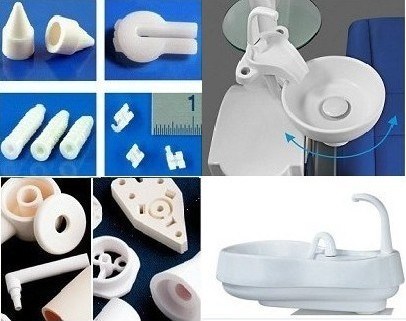Ceramic Injection Molding
Ceramic injection molding (CIM) technology is used to fabricate small, intricately shaped components to high dimensional accuracy without the need for secondary operations.
The unique benefits of Sincora advanced ceramic components set specification standards that cannot be met by similar products made from metals or plastics. Sincora's ceramics offer the medical industry the following key benefits:
Biocompatibility
Electrical Insulation
Temperature Resistance
Dimensional Stability
Flexural Strength
Wear Resistance
Proprietary state-of-the-art ceramic processing techniques are used at Sincora to produce medical components to exacting tolerances under ISO 9001: 2000 quality standards. Processing techniques include pressing, ceramic injection molding, hot isostatic pressing (HIPing) and precision diamond grinding
There are five steps to the Sincora CIM process.
1. Tool Design and Manufacture
A key element in the success of the process is the ability to design tooling that is complimentary to both the requirements of the finished part and the potential complications of the subsequent manufacturing steps. Tool design must also consider the flow characteristics of the specific powder/binder feed stock. This parameter relates to runner design as well as gate size, positioning and configuration.
As with plastic injection molding, all tools parting lines, gates and ejector pins. with ceramics, mold construction must also account for the shrinkage rate of the materia.
An as-molded ceramic component has a consistency similar to a cake of soap. The ejection system must accommodate a delicate part.
2. Mixing
Sub-micron size ceramic powders are mixed thermo-mechanically with a proprietary multi-component blend of binder constituents. The end result is a homogeneous blend of materials that is cooled and granulated for use as a molding feedstock.
3. Molding
Components are molded in plastic injection-molding machines. The feedstock is gravity fed into the barrel of the molding machine where it is heated and moved up to the nozzle by a screw rotating in the barrel. The screw then plunges forward and rams the material through the nozzle into the cavity configured to the required shape.
When the material in the cavity cools sufficiently to hold its shape, the machine opens the tool along the parting line and ejector pins are activated to push the part out of the cavity. The machine then closes the tool and the process is repeated.
At this stage of the process, the component is referred to as a green part. It is common for these components to be produced in tools with multiple cavities thereby increasing productivity and reducing unit component cost.
4. Debinding
Green parts are next treated in a proprietary solvent binder extraction process. All but one of the binder ingredients are removed at this point.
The remaining binder ingredient is called the backbone and functions to hold the geometry of the green part until it is sintered. This process results in a porous body that creates the pathways for the remaining binder ingredient to escape without damaging the part during the sintering process.
5. Sintering
The green part is then placed in one of several high temperature furnaces. The firing atmosphere required by the particular ceramic powder dictates the specific type of furnace utilized.
During sintering, the part will experience shrinkage ranging from 15% to 30%. This is determined by the binder system and ceramic powder being utilized. The fully sintered parts retain the complex shape of the molded part and close dimensional tolerances can be achieved.
Sincora Industry&Trade Co., Ltd found in 2003, Sincora is a professional manufacturer specialized in development and production of dental equipment, and our business is also involving molding development and research and development of medical equipments. Our plant is located in Foshan high-tech industrial area, China. All of our products comply with international quality standards and are greatly appreciated in a variety of different markets throughout the world.
Sincora's Vision & Mission
Mission
To conceive, study, design, and manufacture technically advanced dental and medical instruments, combining tradition and craftsmanship with innovation and technology in a system of excellence.
Vision
To provide patients with the greatest comfort in terms of ergonomics, accessibility and functionality, as well as aesthetic, tactile and visual pleasure, based on constant research and innovation.
Values
Integrity
Respect for the environment
Involving and enhancing human resources
Corporate Culture:
1. Concern for People
2. Provide opportunities and assist in self-development
3. Provide an atmosphere encouraging self-satisfaction and pride
4. Encourage team effort
5. Maintain complete fairness, honesty and integrity
6. Maintain open consistent and regular communication
7. Encourage public service
8. Encourage creativity
9. Commitment to productivity and quality
10. Maintain consistency
11. Dedication to improvement
12. Keep things simple and basic
13. Build on the basis of 'need'
14. Attention to detail
15. Conserve resources
If you have any queries please sent email, fax or call us directly.
